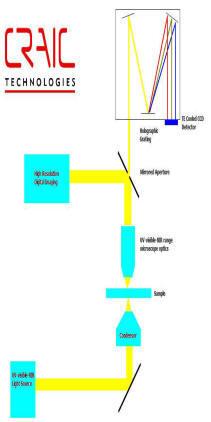Algorithms used for Microspectroscopy

Transmittance
Transmittance calculates a transmission spectrum from a sample and reference single-beam spectra.
From Two Single-Beam Spectra Transmission can produce a transmission spectrum from two single-beam spectra using the following formula:
where R is the single beam spectrum of the reference material, S is the single beam spectrum of the sample and D is the dark counts of the system.
From Absorbance Data:
A transmission spectrum can be generated from an absorbance spectrum using the following formula:
where A is the absorbance value. This is a calculation from data that has already been collected.
Absorbance
Absorbance calculates an absorbance spectrum from a sample and reference single-beam spectra or from a transmission spectrum.
From Two Single-Beam Spectra:
Absorbance can produce an absorbance spectrum from two single-beam spectra using the following formula:
where R is the single beam spectrum of the reference material, S is the single beam spectrum of the sample and D is the dark counts of the system.
From Transmission Data:
Absorbance can also generate an absorbance spectrum from a transmission spectrum using the following formula:

where %T is the percent transmittance value. This is a calculation from data that has already been collected.
Reflectance
Reflectance calculates a reflectance spectrum from a sample and reference single-beam spectra or from an log 1/R spectrum.
From Two Single-Beam Spectra:
Reflectance can produce a reflectance spectrum from two single-beam spectra using the following formula:
where R is the single beam spectrum of the reference material, S is the single beam spectrum of the sample and D is the dark counts of the system.

